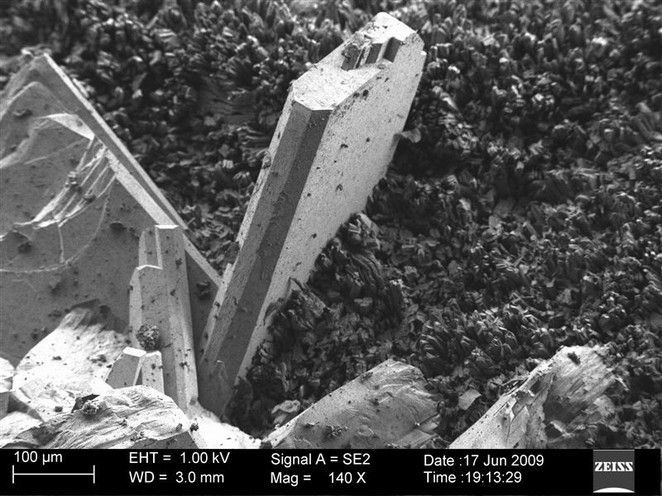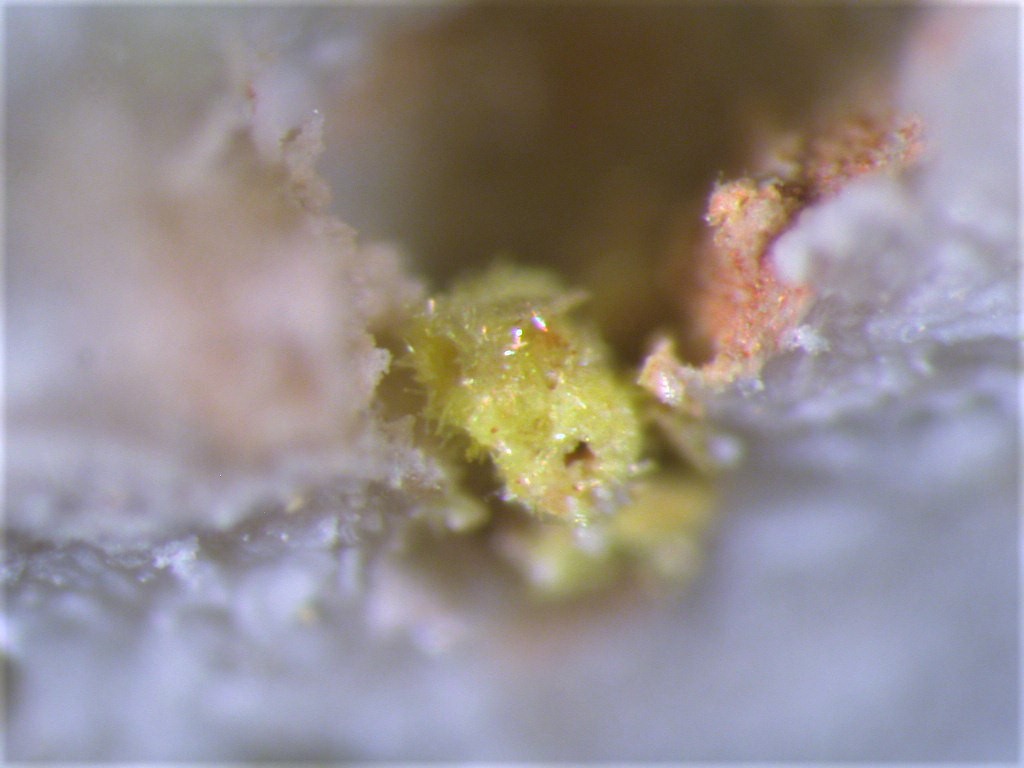Rameauite
A valid IMA mineral species
This page is currently not sponsored. Click here to sponsor this page.
About Rameauite
Formula:
K2Ca(UO2)6O6(OH)4 · 6H2O
Colour:
Orange
Specific Gravity:
5.60
Crystal System:
Monoclinic
Name:
Named after Jacques Rameau (1926-1960), French prospector with the Commissariat à l'Energie Atomique, who discovered the deposit where the mineral was found.
Recent structure refinement shows that it is based on sheets with the β-U3O8 topology, and there are UO6 and UO7 bipyramids; similar sheets are found in spriggite, ianthinite, and wyartite. Adjacent sheets in rameauite are linked via K–O, Ca–O and H bonds. The interlayer space hosts K, Ca and water. The interstitial cations are linked to form infinite chains extending along [101].
Pseudo-tetragonal due to cell twinning.
Pseudo-tetragonal due to cell twinning.
Unique Identifiers
Mindat ID:
3356
Long-form identifier:
mindat:1:1:3356:1
GUID
(UUID V4):
(UUID V4):
5f49111a-5dde-43c9-96b0-36bbd312a3e5
IMA Classification of Rameauite
Approved
Approval year:
1971
First published:
1972
Classification of Rameauite
4.GB.05
4 : OXIDES (Hydroxides, V[5,6] vanadates, arsenites, antimonites, bismuthites, sulfites, selenites, tellurites, iodates)
G : Uranyl Hydroxides
B : With additional cations (K, Ca, Ba, Pb, etc.); with mainly UO2(O,OH)5 pentagonal polyhedra
4 : OXIDES (Hydroxides, V[5,6] vanadates, arsenites, antimonites, bismuthites, sulfites, selenites, tellurites, iodates)
G : Uranyl Hydroxides
B : With additional cations (K, Ca, Ba, Pb, etc.); with mainly UO2(O,OH)5 pentagonal polyhedra
5.5.2.1
5 : OXIDES CONTAINING URANIUM OR THORIUM
5 : AX3O10·xH2O
5 : OXIDES CONTAINING URANIUM OR THORIUM
5 : AX3O10·xH2O
7.16.12
7 : Oxides and Hydroxides
16 : Oxides of U
7 : Oxides and Hydroxides
16 : Oxides of U
Mineral Symbols
As of 2021 there are now IMA–CNMNC approved mineral symbols (abbreviations) for each mineral species, useful for tables and diagrams.
| Symbol | Source | Reference |
|---|---|---|
| Rme | IMA–CNMNC | Warr, L.N. (2021). IMA–CNMNC approved mineral symbols. Mineralogical Magazine, 85(3), 291-320. doi:10.1180/mgm.2021.43 |
Physical Properties of Rameauite
Colour:
Orange
Cleavage:
Distinct/Good
On {010}.
On {010}.
Density:
5.60 g/cm3 (Measured) 5.467 g/cm3 (Calculated)
Optical Data of Rameauite
Type:
Biaxial (-)
Dispersion:
relatively weak
Optical Extinction:
X = b; Z ∧ c = 4°–6°.
Reflectivity:
| Wavelength | R1 | R2 |
|---|---|---|
| 400nm | 14.1% | 15.2% |
| 420nm | 11.9% | 12.4% |
| 440nm | 11.1% | 11.5% |
| 460nm | 10.9% | 11.2% |
| 480nm | 10.6% | 10.9% |
| 500nm | 10.4% | 10.7% |
| 520nm | 10.5% | 10.7% |
| 540nm | 10.7% | 10.9% |
| 560nm | 10.6% | 10.8% |
| 580nm | 10.4% | 10.6% |
| 600nm | 10.3% | 10.5% |
| 620nm | 10.2% | 10.4% |
| 640nm | 10.2% | 10.3% |
| 660nm | 10.0% | 10.1% |
| 680nm | 10.0% | 10.1% |
| 700nm | 9.9% | 10.0% |
Graph shows reflectance levels at different wavelengths (in nm). Top of box is 100%. Peak reflectance is 15.2%.
R1 shown in black, R2 shown in red
Comments:
Reflectivity on face {010}.
Chemistry of Rameauite
Mindat Formula:
K2Ca(UO2)6O6(OH)4 · 6H2O
Crystallography of Rameauite
Crystal System:
Monoclinic
Class (H-M):
m - Domatic
Space Group:
Bb
Setting:
Cc
Cell Parameters:
a = 13.947(3) Å, b = 14.300(3) Å, c = 13.888(3) Å
β = 118.50(3)°
β = 118.50(3)°
Ratio:
a:b:c = 0.975 : 1 : 0.971
Unit Cell V:
2,434.19 ų (Calculated from Unit Cell)
Z:
2
Morphology:
Twinned on {100}, slightly flattened parallel to {010}, elongated parallel to [001], with a pseudo-hexagonal section. Forms include {010}, {100}, {001}, and {110}.
Twinning:
Type material always twinned on {100}.
Comment:
As in agrinierite, cell twinning occurs due to a mirror in (101), i.e., due to reticular merohedry (diffraction type II); the supercell is pseudo-tetragonal
X-Ray Powder Diffraction
Powder Diffraction Data:
| d-spacing | Intensity |
|---|---|
| 7.12 Å | (very very strong) |
| 3.495 Å | (very very strong) |
| 3.139 Å | (very very strong) |
| 3.124 Å | (very very strong) |
| 3.566 Å | (very strong) |
| 3.473 Å | (very strong) |
| 3.185 Å | (very strong) |
Comments:
Margnac mine, France. Data from the type description.
Geological Environment
Paragenetic Mode(s):
| Paragenetic Mode | Earliest Age (Ga) |
|---|---|
| Stage 7: Great Oxidation Event | <2.4 |
| 47a : [Near-surface hydration of prior minerals] | |
| 47f : [Uranyl (U⁶⁺) minerals] |
Type Occurrence of Rameauite
General Appearance of Type Material:
Small (up to 1 mm long) orange crystals, twinned.
Place of Conservation of Type Material:
University of Pierre and Marie Curie, Paris, France.
National School of Mines, Paris, France.
National Museum of Natural History, Washington, D.C., USA, 137454.
National School of Mines, Paris, France.
National Museum of Natural History, Washington, D.C., USA, 137454.
Geological Setting of Type Material:
Oxidized zone of a uranium deposit.
Associated Minerals at Type Locality:
Reference:
Cesbron, F., Brown, W. L., Bariand, P., Geffroy, J. (1972) Rameauite and Agrinierite, two new hydrated complex uranyl oxides from Margnac, France. Mineralogical Magazine: 38: 781-789.
Synonyms of Rameauite
Other Language Names for Rameauite
Common Associates
Associated Minerals Based on Photo Data:
| 2 photos of Rameauite associated with Urancalcarite | Ca(UO2)3(CO3)(OH)6 · 3H2O |
| 2 photos of Rameauite associated with Uranophane | Ca(UO2)2(SiO3OH)2 · 5H2O |
| 1 photo of Rameauite associated with Uraninite | UO2 |
| 1 photo of Rameauite associated with Schoepite | (UO2)8O2(OH)12 · 12H2O |
Related Minerals - Strunz-mindat Grouping
| 4.GB.05 | Agrinierite | K2(Ca,Sr)[(UO2)3O3(OH)2]2 · 5H2O |
| 4.GB.05 | Compreignacite | K2(UO2)6O4(OH)6 · 7H2O |
| 4.GB.10 | Becquerelite | Ca(UO2)6O4(OH)6 · 8H2O |
| 4.GB.10 | Billietite | Ba(UO2)6O4(OH)6 · 4-8H2O |
| 4.GB.10 | Protasite | Ba(UO2)3O3(OH)2 · 3H2O |
| 4.GB.15 | Richetite | (Fe3+,Mg)Pb 8.6(UO2)36O36(OH)24 · 41H2O |
| 4.GB.20 | Bauranoite | Ba(UO2)2(OH)6 · 1-2H2O |
| 4.GB.20 | Calciouranoite | (Ca,Ba,Pb)U2O7 · 5H2O |
| 4.GB.20 | Metacalciouranoite | (Ca,Ba,Pb,K2)U2O7 · 2H2O |
| 4.GB.25 | Fourmarierite | Pb(UO2)4O3(OH)4 · 4H2O |
| 4.GB.30 | Wölsendorfite | Pb7(UO2)14O19(OH)4 · 12H2O |
| 4.GB.35 | Masuyite | Pb(UO2)3O3(OH)2 · 3H2O |
| 4.GB.40 | Metavandendriesscheite | PbU7O22 · nH2O n < 12 |
| 4.GB.40 | Vandendriesscheite | PbU7O22 · 12H2O |
| 4.GB.45 | Vandenbrandeite | Cu(UO2)(OH)4 |
| 4.GB.50 | Sayrite | Pb2(UO2)5O6(OH)2 · 4H2O |
| 4.GB.55 | Curite | Pb3(H2O)2[(UO2)4O4(OH)3]2 |
| 4.GB.60 | Iriginite | (UO2)Mo2O7 · 3H2O |
| 4.GB.65 | Uranosphaerite | Bi(UO2)O2(OH) |
| 4.GB.70 | Holfertite | CaxU6+2-xTi(O8-xOH4x) · 3H2O |
| 4.GB.75 | Carlosbarbosaite | (UO2)2Nb2O6(OH)2 · 2H2O |
| 4.GB.80 | Gauthierite | KPb[(UO2)7O5(OH)7] · 8H2O |
| 4.GB.85 | Kroupaite | KPb0.5[(UO2)8O4(OH)10] · 10H2O |
| 4.GB.90 | Leesite | K(H2O)2[(UO2)4O2(OH)5] · 3H2O |
| 4.GB.95 | Shinkolobweite | Pb1.25[U5+(H2O)2(U6+O2)5O8(OH)2](H2O)5 |
| 4.GB.95 | Nollmotzite | Mg[U5+(U6+O2)2O4F3] · 4H2O |
Other Information
Health Risks:
No information on health risks for this material has been entered into the database. You should always treat mineral specimens with care.
Internet Links for Rameauite
mindat.org URL:
https://www.mindat.org/min-3356.html
Please feel free to link to this page.
Please feel free to link to this page.
Search Engines:
External Links:
Mineral Dealers:
References for Rameauite
Localities for Rameauite
Locality List
 - This locality has map coordinates listed.
- This locality has map coordinates listed.
 - This locality has estimated coordinates.
ⓘ - Click for references and further information on this occurrence.
? - Indicates mineral may be doubtful at this locality.
- This locality has estimated coordinates.
ⓘ - Click for references and further information on this occurrence.
? - Indicates mineral may be doubtful at this locality.
 - Good crystals or important locality for species.
- Good crystals or important locality for species.
 - World class for species or very significant.
(TL) - Type Locality for a valid mineral species.
(FRL) - First Recorded Locality for everything else (eg varieties).
- World class for species or very significant.
(TL) - Type Locality for a valid mineral species.
(FRL) - First Recorded Locality for everything else (eg varieties).
All localities listed without proper references should be considered as questionable.
Brazil | |
| Pires et al. (2014) |
DR Congo | |
| King (n.d.) |
France | |
| Patrice Queneau Collection |
| Cesbron et al. (1972) |
Nigeria | |
| Tsang et al. (2018) |
Switzerland | |
| Meisser (2012) |
| Meisser (2012) |
USA | |
| Anthony et al. (1995) +1 other reference |
| Castor et al. (2004) |
Quick NavTopAbout RameauiteUnique IdentifiersIMA Classification Classification Mineral SymbolsPhysical Properties Optical Data Chemistry Crystallography X-Ray Powder DiffractionGeological EnvironmentType Occurrence SynonymsOther LanguagesCommon AssociatesStrunz-MindatOther InformationInternet Links References Localities Locality List






 symbol to view information about a locality.
The
symbol to view information about a locality.
The 



Margnac Mine, Compreignac, Bellac, Haute-Vienne, Nouvelle-Aquitaine, France